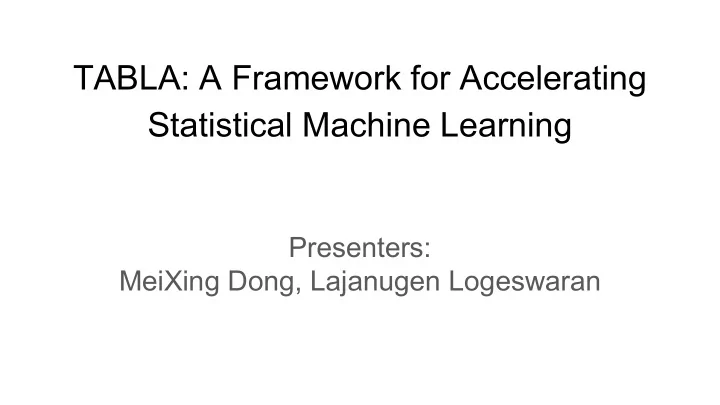

TABLA: A Framework for Accelerating Statistical Machine Learning Presenters: MeiXing Dong, Lajanugen Logeswaran
Intro ● Machine learning algorithms widely used, computationally CAT intensive ● FPGAs get performance gains w/ flexibility ISTOCK/ANNA LURYE ● Development for FPGAs expensive and long ● Automatically generate accelerators (TABLA) * Unless otherwise noted, all figures from Mahajan, Divya, et al. "Tabla: A unified template-based framework for accelerating statistical machine learning." High Performance Computer Architecture (HPCA), 2016 IEEE International Symposium on. IEEE, 2016.
Stochastic Gradient Descent ● Machine learning uses objective (cost) functions ● Ex. linear regression objective: ∑ i 1/2(w T x i - y i ) 2 + λ||w|| ○ gradient: ∑ i (w T x i - y i )x i + λ||w|| ○ ● Want to find lowest value possible w/ gradient descent ● Can approximate batch update Src: https://alykhantejani.github.io/a-brief-introduction-to-gradient-descent/
Overview Accelerator Design DFG Src: http://act-lab.org/artifacts/tabla/
Programming Interface ● Language ○ Close to mathematical expressions ○ Language constructs commonly used in ML algorithms ● Why not MATLAB/R ? ○ Identifying parallelizable code ○ Conversion to hardware design
Model Compiler Specify Model Dataflow Schedule and Gradient Graph Operations ● Model parameters and ● Minimum-Latency Resource gradient are both arrays of Constrained Scheduling values + + ● Priority placed on highest ● Gradient function distance from sink specified using math ● Predecessors scheduled ● Ex. ● Resources available * ○ g[j][i] = u*g[j][i] ○ g[j][i] = w[j][i] - g[j][i] Output
Accelerator Design: Design builder ● Generates Verilog of accelerator from ○ DFG, algorithm schedule, FPGA spec ● Clustered hierarchical architecture ● Determines ○ Number of PEs ○ Number of PEs per PU ● Generate ○ Control units and buses ○ Memory interface unit and access schedule
Accelerator Design: Processing engine ● Basic block ● Fixed components ○ ALU ○ Data/Model buffer ○ Registers ○ Busing logic ● Customizable components ○ Control unit ○ Nonlinear unit ○ Neighbor input/output communication
Accelerator Design: Processing unit ● Group of PEs ○ Modular design ○ Data traffic locality within PU ● Scale up as necessary ● Static communication schedule ○ Global bus ○ Memory access
Evaluation
Setup ● Implement TABLA using off-the-shelf FPGA platform (Xilinx Zynq ZC702) ● Compare with CPUs and GPUs ● 5 popular ML algorithms ○ Logistic Regression ○ Support Vector Machines ○ Recommender Systems ○ Backpropagation ○ Linear Regression ● Measurements ○ Execution time ○ Power
Performance Comparison
Power Usage
Design Space Exploration ● Number of PEs vs PUs ○ Configuration that provides highest frequency ■ 8 PEs per PU ● Number of PEs ○ Initially linear increase ○ Poor performance after a certain point ● Too many PEs ○ Wider global bus - Reduced frequency
Design Space Exploration ● Bandwidth sensitivity ○ Increase bandwidth between external memory and accelerator ○ Limited improvement ■ Computation dominates execution time ■ Frequently accessed data are kept in PE’s local buffers
Conclusion ● Machine learning algorithms popular but compute-intensive ● FPGAs are appealing for accelerating performance ● FPGA design long and expensive ● Automatically generate accelerators for learning algorithms using template-based framework (TABLA)
Discussion Points ● Is this more useful than accelerators specialized for gradient descent? ● Is this solution practical? (Cost, Scalability, Performance) ● Is this idea generalizable to problems other than gradient descent?
Recommend
More recommend